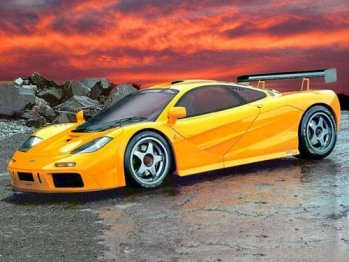At the end of the 1980s, McLaren were virtually unassailable in Formula 1 racing. They had won championships in '84, '85, '88 and '89. In 1988, the team - with all of the advanced technology and expertise at their disposal - decided to build the ultimate sports 'supercar' for the road. A new company, McLaren Cars Ltd, was set-up to design, develop and build them.
Gordon Murray, then technical boss of the McLaren F1 team, was tasked with the job of designing the car and, knowing there would be a market for such a product, was given the brief to "design "the best car possible, regardless of cost". Thus, the project would employ many of the technologies used in Formula 1 racing.
The balancing act
Around the same time, Ferrari were also developing a new car that would offer the driver a 'Formula 1 type experience' on the road. They eventually approached this by using a Formula 1-based engine to give the 'F1 feel'. McLaren's approach was different and innovative.
Although it was to be a mid-engined three-seater, the driver of the F1 would be positioned at the absolute centre of the car's mass - as in a single-seat racing car. This concept had been in Murray's mind since his days at college but the idea took many hours of development to realise in practice.
Murray also configured the car to have the lowest polar moment of inertia as possible. This meant finding ways to position all of the high mass components (engine, gearbox, electrics etc) between the front and rear axles, ensuring that the vehicle would instantly respond to changes of direction at high-speed. Packaging all of these requirements into a road legal car was a significant challenge.
Fast, light and very strong (part one)...
To ensure that the F1 provided the 'ultimate driving experience', from the outset Gordon Murray insisted on a V12 engine and a maximum kerb weight for the entire vehicle of just 1000 kg.
Although it was generally expected for the F1 to have a Honda engine (the McLaren Grand Prix team's engine supplier at the time) the company turned eventually to BMW. The Bavarian company entered into the project with great enthusiasm, designing and manufacturing an all-new dedicated lightweight V12, 6000cc unit designated 'type S70/2' at their Munich headquarters in the space of a few months.
Styling-wise, the car was optimised for maximum aerodynamic efficiency, providing a very low Cd value (drag co-efficient) combined with maximised downforce for high-speed handling. To achieve these competing requirements, the design team headed for the wind tunnel and developed a flat floor with a diffuser as seen in Formula One. Aditionally, the diffuser was tweaked to work with the cooling airflow, obtaining very efficient downforce.
Fast, light and very strong (part two)...
As in a Formula 1 racer, the bodywork was to be hand-made entirely from carbon composite materials (CFRP). CFRP is the material of choice for the engineer looking to create an enormously strong and rigid structure with minimal weight. The McLaren Formula One team had pioneered it's use in Grand Prix racing just a few years earlier.
The strength to weight ratio of carbon composites materials far exceeds that of steel or aluminium alloys. The material can also be isotropic, meaning that it has the same strength in any direction that a stress is applied. As such the McLaren, whilst weighing just 1140 kg, was reported to be the only car ever to be able to drive away from a crash test at the Motor Industry Research Association (MIRA) testing facility in the UK. Mechanically, the car was as sound as the day it rolled off the production line - only the headlamps, which had popped out under the impact load, prevented the crashed car from full road legality. It would be wonderful if all cars were built from these exceptional materials but, unfortunately, the very high cost of CFRP and the manual fabrication process and expensive plant required makes this economically prohibitive for now.
A particularly remarkable feature of the F1 was born of the necessity to compromise and innovate. The 1000kg kerb weight was regarded with such importance that, when BMW told Gordon Murray's team that an exhaust system able to cope with the amount of heated gas produced by the 6.1 litre engine would weigh in at almost 100 kg, some innovative thinking was required. In fact, the unit was eventually manufactured from Inconel, a lightweight alloy used primarily in jet engines. Most intriguing of all, it was decided that the massive 65-litre silencer would act as part of the rear crash structure, eliminating the need for additional components behind the engine.
Million dollar car
The sophistication of the car was refelected in its �640,000 or US $1m list price tag, but this sort of money bought a host of amazing features. The expansive and steeply raked windshield wrapped around the cabin and resulted in exceptionally good visibility. At the rear was an electronically deployed wing to enhance stability under braking. Kenwood developed a unique and dedicated extra-lightweight in-car CD system. McLaren F1 luggage and golf bags were included, specially produced to fit inside the contours and limited space of the body shape. Finally, as with a Formula 1 car, the carbon composite drivers seat was individually moulded to suit the owner's body shape. The F1 went on sale in 1993.
|


